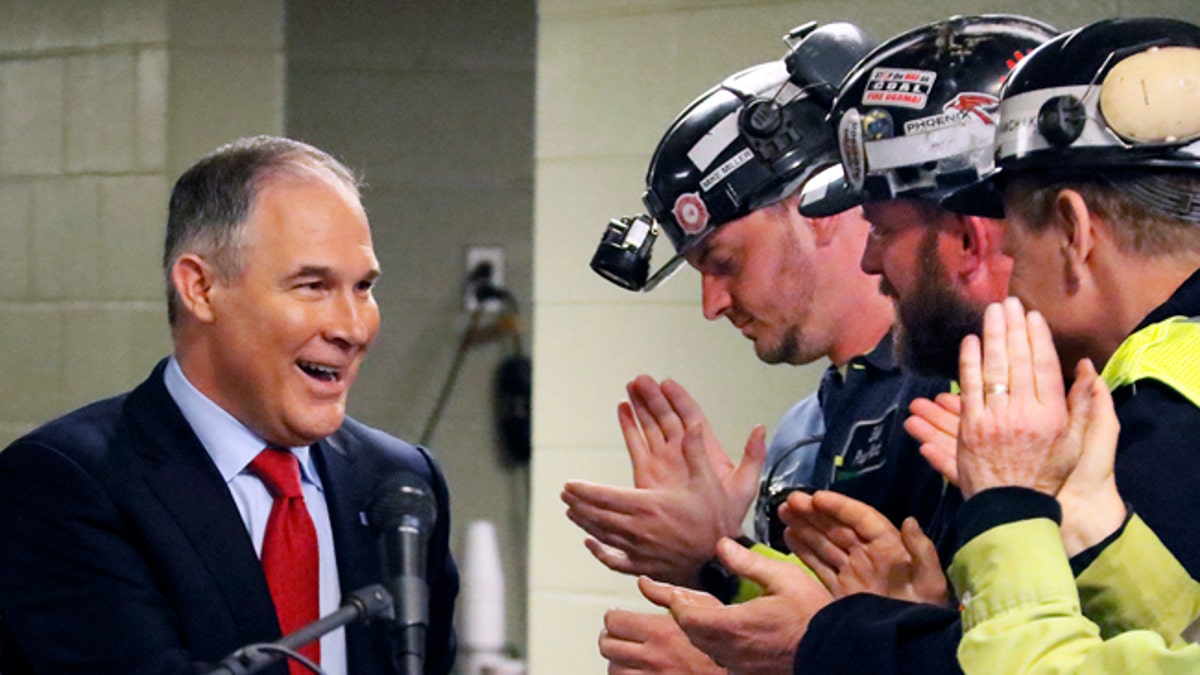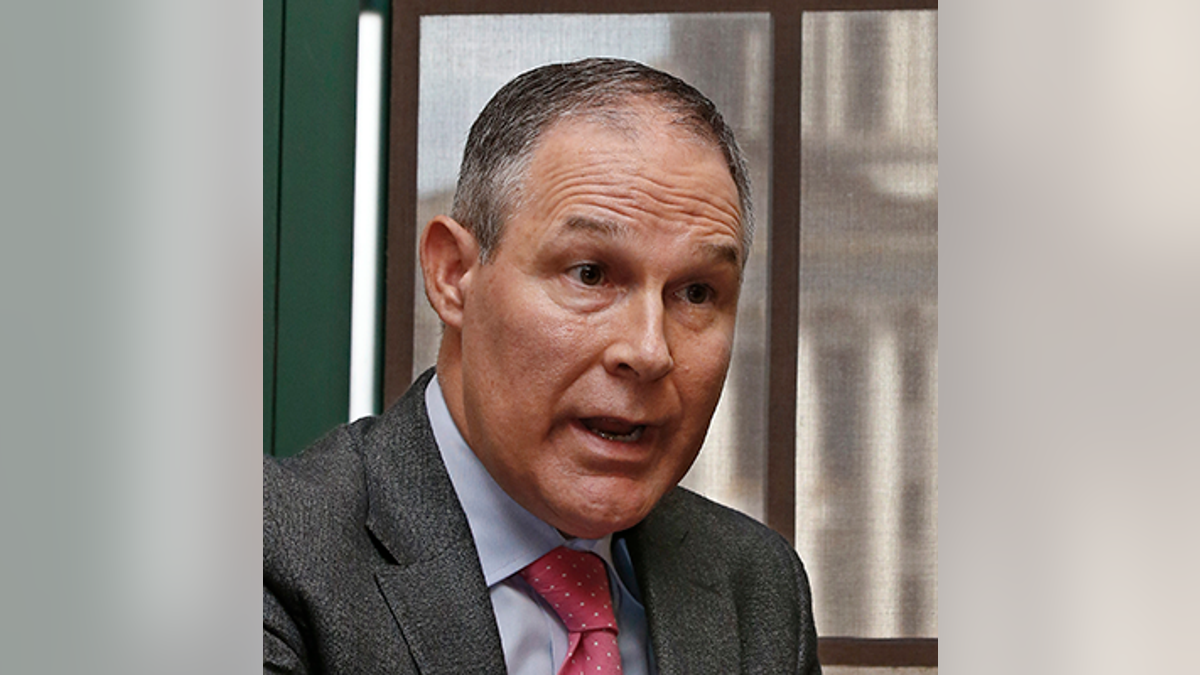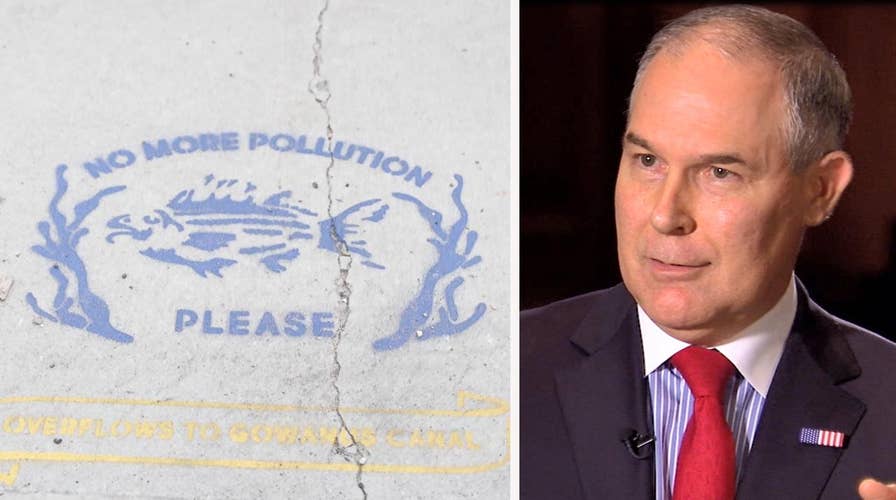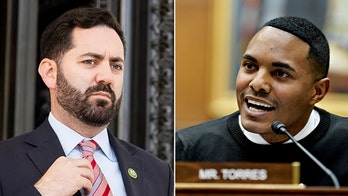EPA chief Scott Pruitt shifts focus to Superfund cleanups
EPA chief Scott Pruitt shifts agency focus from climate change to Superfund site cleanups, but some local residents, like those near the Gowanus Canal in Brooklyn, are still waiting to see progress
New York – The stench is the first thing you notice.
The smell of Brooklyn’s Gowanus Canal is a mix of raw sewage, industrial chemicals and stagnant salt water that assaults the nostrils and – especially for anyone visiting the area on a full stomach – can be nausea-inducing. On certain hot and humid summer afternoons, the stench is so pervasive that it can be detected blocks away.
“It’s always been a smelly mess, it’s disgusting,” August Garbellotto, a 77-year-old Brooklyn resident who has lived his entire life within walking distance of the canal, told Fox News. “Some of the things you flush away go in there.”
The 1.8-mile-long canal, which since 1850 has been a dumping ground for the waste and heavy metals generated by nearby gas plants, chemical plants, tanneries and other industries – is one of the nation’s most seriously contaminated bodies of water and has led the Environmental Protection Agency in 2010 to declare the waterway a Superfund site.
Since then, however, the cleanup process has progressed at a glacial pace as the EPA fights with the city of New York and the companies responsible for some of the environmental damage. So far dredgers have removed some old tires and boat parts from the canal and there are plans to start scooping out the toxic sludge known as “black mayonnaise” from the canal’s bottom sometime in the next two years, but sewage still continues to flow into the water and locals are increasingly concerned about the health risks of living so close to the site.
“The Gowanus Canal is one of the most densely populated toxic waste sites in the entire country,” Joseph Alexiou, the author of “Gowanus: Brooklyn’s Curious Canal,” told Fox News. “In the immediate neighborhood there are approximately 30,000 to 40,000 people here.”
The canal and the hundreds of other Superfund sites that have languished for years amid government red tape have become the major focus of EPA Administrator Scott Pruitt’s “back to basics” approach to the agency that he outlined in April during a visit to a Pennsylvania coal mine.
“What’s very important in my estimation is that we look at what this agency does and that we actually show tremendous progress and meaningful progress with respect to those Superfund sites across the country,” Pruitt told Fox News in an interview at EPA headquarters. “To reenergize that focus, to get leadership in place to focus on real progress is something that I think the American citizens deserve.”
Superfund sites were first established by Congress in 1980 in part as a response to large-scale environmental pollution disasters like the Love Canal in Niagara Falls, N.Y., and the Valley of the Drums toxic waste site near Louisville, Ky. Since then, the number of sites designated by the federal government has ballooned to more than 1,300 despite Congress allocating about $1.26 billion of general revenue to the program each year from 2000 to 2015.
According to a study conducted by the Center for Health, Environment and Justice, the number of Superfund cleanups completed each year has decreased from 88 in 1997 to just eight in 2014.

In this Tuesday, July 5, 2016 photo, a view of the ongoing construction for the new 363 Bond Street apartments, a new development from Lightstone, along Brooklyn's Gowanus Canal, in New York. The canal is a Superfund site polluted with decades' worth of industrial waste and sewage, but the developer says the pending more than half a billion dollars cleanup of the toxic waterway hasn't deterred tenants from flocking to the building, where the rent for a one-bedroom apartment starts in the low $3,000s. (AP Photo/Bebeto Matthews) (AP)
Labeling himself as an “EPA originalist,” Pruitt wants to narrow the focus of the agency’s work to what he sees as its original mission. That means focusing efforts at Superfund, Brownfield and other polluted sites while cutting back numerous Obama-era regulations aimed at curbing climate change and allow for greater economic growth and engagement on the state level.
“This is a matter of focus and priority,” Pruitt said. “It’s a matter of saying that it’s unacceptable for bureaucrats in Washington D.C. to let these sites languish. This is a call to really do something about the leadership to serve Americans interest across the country.”
To that end, Pruitt established the Superfund Task Force in May to map a new direction for the decades-old program. Earlier this week, Pruitt signed a directive on 11 specific actions that the EPA should implement to hasten the pace of cleanup at Superfund sites.
Pruitt’s call to speed up the Superfund process has generally been met with positive reviews – no small feat for an EPA administrator maligned by many for his climate change skepticism and close ties to oil and gas heavyweights.
“What’s important is that the environmental impact is properly monitored,” Mark Templeton, the director of the Abrams Environmental Law Clinic at the University of Chicago Law School, told Fox News. “The Superfund process has been very slow, so it needs to be sped up but it also needs to be done safely.”
But there is still a concern that a rush to check off sites on the ever-expanding list could lead to shoddy work at best and, at worst, cause more environmental harm than good.
Superfund Stats
- Superfund sites were first established by Congress in 1980 in part as a response to largescale environmental pollution disasters like the Love Canal in Niagara Falls, New York and the Valley of the Drums toxic waste site near Louisville, Kentucky.
- The number of sites designated by the federal government has ballooned to more than 1,300 despite Congress allocating about $1.26 billion of general revenue to the program each year from 2000 to 2015.
- According to a study conducted by the Center for Health, Environment and Justice, the number of Superfund cleanups completed each year has decreased from 88 in 1997 to just 8 in 2014.
That concern is magnified by Pruitt’s own record prior to taking the helm at the agency. During his tenure as the Oklahoma attorney general, Pruitt sued the EPA more than a dozen time and also coordinated with major oil and gas producers, electric utilities and political groups with ties to the libertarian billionaires the Koch brothers to roll back environmental regulations. In his first few months at the EPA, he was instrumental in convincing President Donald Trump to pull out of the Paris Climate Agreement and recently challenged climate scientists to prove the threat of global warming.
Many skeptics of Pruitt argue that the scope of the EPA has expanded since its formation in 1970 and it should now tackle issues like climate change alongside environmental cleanups.
“I don’t think it has to be an either-or, nor should it be,” Christine Todd Whitman, former President George W. Bush’s first EPA administrator, told Politico. “Superfund is not the only issue for human health. Water pollution is a huge issue and very important and you need to work on it, but it’s not the only issue. Air is an issue too. Even if you don’t want to believe in climate change, you've got to believe that carbon and mercury are not good for you.”
When questioned about Whitman’s comments, Pruitt said that focusing on Superfund sites was not about ignoring air or water quality, but about making progress on projects that can be completed. Pruitt argued that the Obama administration left many projects untouched and it was his job to tackle those issues.
“We’re moving forward with a positive agenda, setting clear metrics and objectives and that’s far different than what the last administration did,” Pruitt added. “When I came in, there were 700 chemicals that were just waiting there for someone to make a decision on. Guess what, that backlog of chemicals is going to be gone by next month.”
One of those issues Pruitt wants to tackle is the former USS Lead Superfund site in East Chicago, Ill.

FILE - In this April 13, 2017 file photo Environmental Protection Agency (EPA) Administrator Scott Pruitt, left, shakes hands with coal miners during a visit to Consol Pennsylvania Coal Company's Harvey Mine in Sycamore, Pa. The Trump administration wants to trash Obama-era rules to limit water pollution from coal-fired power plants. Pruitt announced the change this week. Administrator Scott Pruitt sent a letter to a coalition of energy companies that lobbied against the 2015 water pollution rule. (AP Photo/Gene J. Puskar, File) (AP)
Located just across the state line from Chicago and along the shores of Lake Michigan, the site of the former lead smelter has left dangerously high levels of lead and arsenic in the soil of nearby low-income neighborhoods.
Residents in East Chicago say they are particularly concerned with the safety of their drinking water, especially in light of the crisis in Flint, Michigan and want to be kept up-to-date on any of the developments at a Superfund site that has been on the EPA’s “worst contaminated” list since 2009.
There is also a simmering anger in East Chicago that despite Pruitt making the site appear to be one if his top priorities, the EPA has stalled its crackdown on Indiana Harbor Coke – the company that continues to spew out illegal-amounts of lead that caused the area to gain Superfund status in the first place.
Pruitt promised that the EPA would institute better communication programs as the cleanup continues in the town and plans to take a more “hands-on approach” in regards to the oversight of the project.
“Progress is being made there by ensuring there is safe drinking water through filters and making sure that lead is being addressed in the soil,” Pruitt said. “The objective is to finalize the plan, finalize what’s actually going to be necessary to cleanup [the site].”
Perhaps more than the concerns of speeding up the cleanup efforts or the shift away from battling climate change, Pruitt’s critics wonder where he plans to get the money to follow through on his “back to basics” projects given that the Trump administration has proposed cutting the agency’s budget.

(AP2016)
One White House budget proposal that the EPA wanted aims to reduce EPA funding by more than 31 percent – eliminating several regional programs, nearly halving categorical grants and slashing funding to the Superfund program
“This isn’t a budget — it’s a road map for the President, EPA Administrator Pruitt and polluters to see that millions of Americans drink dirtier water, breathe more polluted air and don’t have enough nutritious food to lead healthy lives,” Ken Cook, president of the Environmental Working Group, said in a statement back in May. “With each cut in EPA funding, each regulatory rollback, each special favor for polluters, it becomes more clear that for President Trump, public health protection is not a priority, but a target.”
The House Appropriations Committee approved last week a spending bill that would begin the process of cutting the EPA budget, but also keep intact vital environmental programs. While the bill cuts the EPA's budget by $528 million for fiscal 2018, it is still far less than Trump had proposed.
Pruitt told detractors that the federal budget hasn’t kept Superfund sites from getting cleaned up because “60 percent of our portfolio approximately of Superfund sites is funded through private parties.” The EPA administrator added that he will take the same approach against the companies responsible for the environmental damage that he took toward the agency when he was Oklahoma Attorney General… he’ll take them to court.
“You go to them and say ‘look, this is what the remediation is, here’s the timeline. You’re responsible for paying for it and you’re going to pay for it,’” Pruitt said. “If they say no, you’re going to enforce it.”
In the case of the Gowanus Canal, the two biggest Potentially Responsible Parties – entities accountable for the environmental damage – are the city of New York itself and utility company National Grid. The city has already committed $80 million toward that project and there is an additional $735 million for it in the 10-year capital plan, but National Grid said it plans to raise monthly heating bills in the Big Apple to help cover its share of cleanup costs.
Despite the costs of the cleanup being covered, New York City lawmakers say that the EPA budget cuts could hinder the effort. The cuts could see 3,500 EPA employees laid off from their jobs and the shuttering of many regional programs.
"We don't need the federal government money to actually clean the canal, the polluters pay to clean the canal, but of course that only works if the EPA can administer the program," New York City Councilman Brad Lander told DNA Info. "[EPA staff] has to be able to get the ball across the finish line … and get the cleanup underway."





